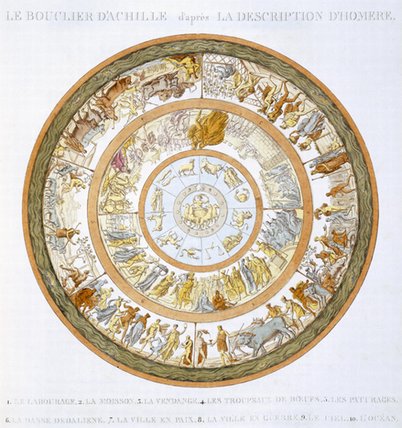Literary Tradition Definition
Although most people today might think that the word tradition is a reference to things from the past that are fixed and therefore must be replicated, the English word tradition actually comes from the Latin infinitive tradere literally meaning “to hand across.” However, the same word frequently meant “to surrender.” The various meanings of the Latin tradere can also be found in Greek words that translate as “tradition.” In both languages, the idea of “tradition” is at once a handing on of customs, rituals, expectations, and methods of doing things outside of written documents and a rejection of such customs or even a betrayal of them. This doublesided meaning of the word, which gives a truer picture of what tradition actually is, can be traced throughout the Western literary canon. From the earliest examples of literary art, the issue of tradition can be seen. For example, in the Babylonian poem Gilgamesh, the goddess Ishtar is outraged that Gilgamesh dishonors her; to punish him, she sends a bull to destroy him. This early example of a god expecting “traditional” behavior from a human, and the human responding by breaking the tradition, sets the stage for conflict found in nearly all classical and biblical literature.
Yet the idea of tradition implies an appeal to stability, an unchanging order of expectations and events that makes human life possible because tradition presumes that tomorrow will be more or less like today. If the breaking up of expectations is also part of the idea of tradition, then one may question when such rejection is warranted and when it will introduce chaos into ordinary life. This problem of tradition—knowing when to maintain it and when to reject it—is a subject for political philosophy. Plato’s dialogue The Republic is structured around an argument in three waves, each of which contradicts the argument presented up to that point. The establishment of a proposition that is then contradicted is very much like the idea of a word, custom, or ritual handed down and then rejected by another contradictory word, the basic meaning of tradition. According to Plato, the wise statesman is the one who knows when to maintain a political order and when to initiate a change that will cause the city to more closely resemble its ideal. Thus, at the very beginnings of Western literature, in Gilgamesh and in The Republic, the idea of tradition contains both a thematic and a political meaning.

Intertextuality in Literature
A third meaning, of intertextuality, can also be seen in ancient literature: the relationship between an earlier writer and a later one. Intertextuality is the influence of a set of written signs on later literary productions; it is neither allusion, allegory, nor a collection of earlier sources but a transposition of elements found in earlier literature and “carried across” to later compositions to create something new.The best example of intertextuality is Virgil’s use of Homer in The Aeneid. Although The Aeneid is sometimes described as The Odyssey first and then The Iliad, with actions merely lifted from Homer, in fact Virgil’s transposition of elements found in Homer’s epics forces readers to reinterpret meanings and thereby imaginatively create new understandings from an epic poetic form that seems “traditional.” For example, the images on Achilles’ shield in The Iliad signify the meaning of the war from the Greek perspective: the city of war, governed by Apollo and Athena; the city of peace, centered on a human marriage, with no gods present; around them plowing, harvesting, dancing, and the ocean.

Aeneas’s shield
In The Aeneid, the images on Aeneas’s shield also function as symbols of the meaning of the battle about to begin: Romulus and Remus; the Sabines; Manlius; Catiline; Julius Caesar; Augustus; and, in the center, the Battle of Actium, which ended the republic and established the Roman Empire. The implication is that these images represent the same civilizational values for the Romans as the cities of war and peace for the Greeks. Yet the changes in the images on Aeneas’s shield do more than merely fit a different plot; these changes affect the audience’s expectation of the meaning of symbol because the entire poem is meant to change their expectation of themselves and their situation after the civil war.
Though both shields contain images important for each civilization, those on Aeneas’s shield have not happened yet as far as Aeneas himself is concerned, but the audience knows they have happened as they show the major events in Roman mythological history. The purpose of such double-sided representation is exactly what tradition, in the form of intertextuality, does. The question Virgil raises for the characters within the story is whether their virtue will be enough to “spare the conquered and battle down the proud,” the rule of law given to Aeneas so that Rome may be founded. Will Aeneas be strong enough and wise enough to show the wisdom necessary for a true ruler of a great city, or will his desire for the past in Troy still affect his judgment? Because the images on the shield remind the audience of the glory of republican Rome, the question being asked of them is whether they have the strength and wisdom necessary to go forward into the imperial future in order to create, through their own practice of virtue, an even greater city than the one Aeneas founded. Can they go forward and not look back to the past, to “tradition”? Thus, in The Aeneid, Virgil combines the thematic and political meanings of tradition through intertextuality by changing the significance of an important literary symbol. In contrast to what has been handed down, these three actions—conflict, wisdom, and intertextuality— can be seen in later literature. In his book The Anxiety of Influence, the literary critic Harold Bloom attempts to describe the stages of change that take place as the ephebe (the younger artist) asserts his voice over the father (the precursor: the elder artist or the tradition).
These are: clinamen, or poetic misreading; tessera, or antithetical completion—that is, finishing the misreading in a logical way; kenosis, a turn away or break from the logical implications of the precursor; demonization, an inspiration derived from the ephebe’s reaction to the precursor, but not contained in it; ascesis, the solitude derived from a movement toward a completed vision; and apophrades, the revisionary image held up to its precursor. Although Bloom’s language derives from Neoplatonism and gnosticism, his description follows the classical tradition as shown above. An earlier critic, T. S. Eliot, also describes the relationship between a new work of literary art and its predecessors in his essay “Tradition and the Literary Talent” (1919). Eliot shows the necessary interaction between a new work and the context in which it appears. For him, the new work is accepted as literary because it fits into the context of which it is a part; in turn, because it is a literary work of art, the new work changes readers’ understanding of the entire tradition by its refiguring of the whole context. Unlike Bloom’s esoteric description, Eliot’s understanding of the literary tradition adds a new component to the term tradition by showing that tradition itself is constantly changing and unstable. In other words, the “tradition” of literary tradition is the constant production of new works added to the canon. The critic must develop the wisdom to decide which new works of art deserve to move the tradition forward and which do not rise to that level. One question that Eliot’s essay raises is, of course, what is meant by a literary tradition.
As we have seen, authors read earlier authors and derive inspiration and innovations from them. The rejection of both subject matter and form creates new subject matter and form for new audiences. The texts that make up this development are called a “tradition” as well. Thus, every linguistic group has some sort of literary tradition, whether oral or written, by which stories give meaning to experience. The particular groupings for literary traditions can be national (English, German, Chinese), formal (epic, tragic, comic, lyric, narrative, poetic, dramatic), or periodic (ancient, medieval, modern.) Within each of these groupings are particularities of form, language, subject matter, worldview, and so on, which identify the work as part of its “tradition” even though, as discussed above, each work will also be unique because of its rejection of some aspect of its tradition. The example of Virgil’s changing Homer is part of the classical tradition, which in turn forms the basis of Western literary tradition, but there are many more. In our global environment, the dynamic meaning of tradition is perhaps more important than ever, for authors writing in their national “traditions” are now borrowing from each other at a very rapid pace, producing a literary environment that in time may change our understanding of literature itself. For example, postcolonial literature borrows from European models but adds native experience and forms into that tradition; Salman Rushdie is perhaps the best-known writer in this tradition.
See also Alexie, Sherman: Lone Ranger and Tonto Fistfight in Heaven, The; Alvarez, Julie: How the García Girls Lost Their Accents; Aristophanes: Frogs, The; Browning, Robert: “My Last Duchess”; Dickens, Charles: Christmas Carol, A; Dreiser, Theodore: American Tragedy, A; DuBois, W. E. B.: Souls of Black Folk, The; Eliot, T. S.: Waste Land, The; Emerson, Ralph Waldo: “Divinity School Address, The”; Erdrich, Louise: Tracks; Euripides: Medea; Faulkner, William: Light in August; Sound and the Fury, The; Forster, E. M.: Room with a View, A; Jackson, Shirley: “Lottery, The”; Kingston, Maxine Hong: Woman Warrior, The; Momaday, N. Scott: House Made of Dawn; Way to Rainy Mountain, The; Naipaul, V. S.: House for Mr. Biswas, A; Reed, Ishmael: Mumbo Jumbo.

Caine Prize Writing Anthology “African Violet” published in Zimbabwe.
RT “: Literature SUCKSSSSS”
1 reminds us that “the world of literature is more social than you might imagine.”
Waiting to drop English literature Good times